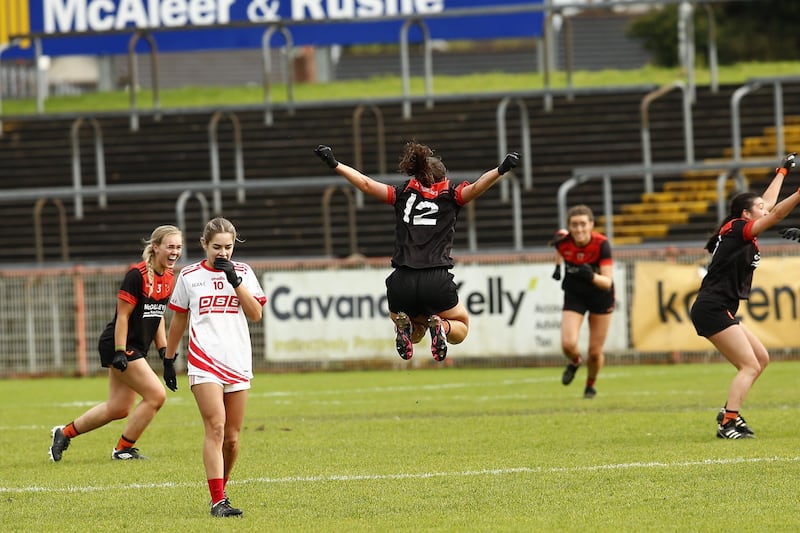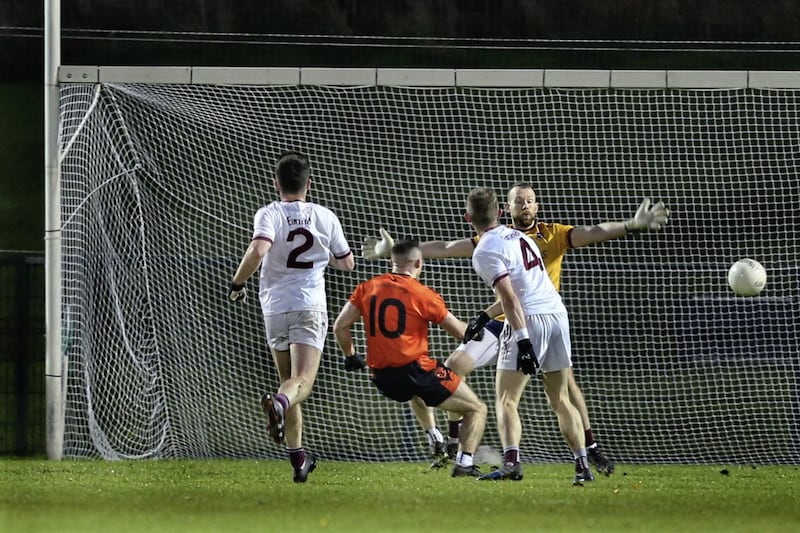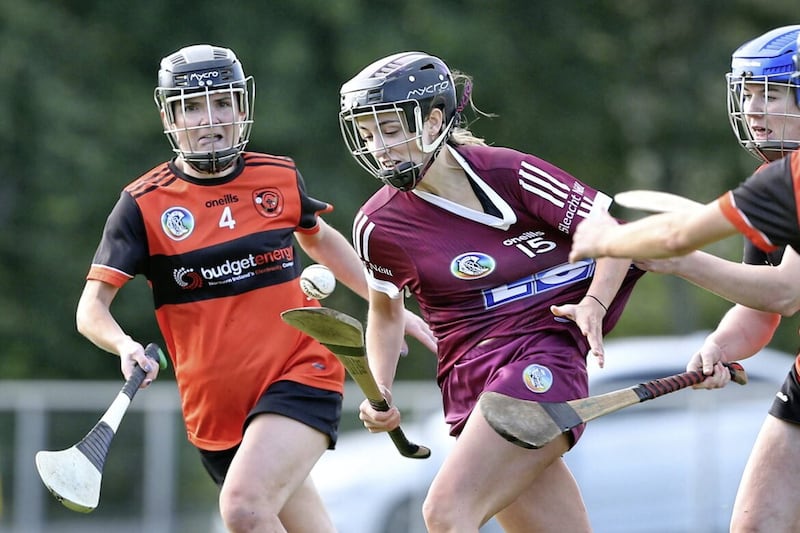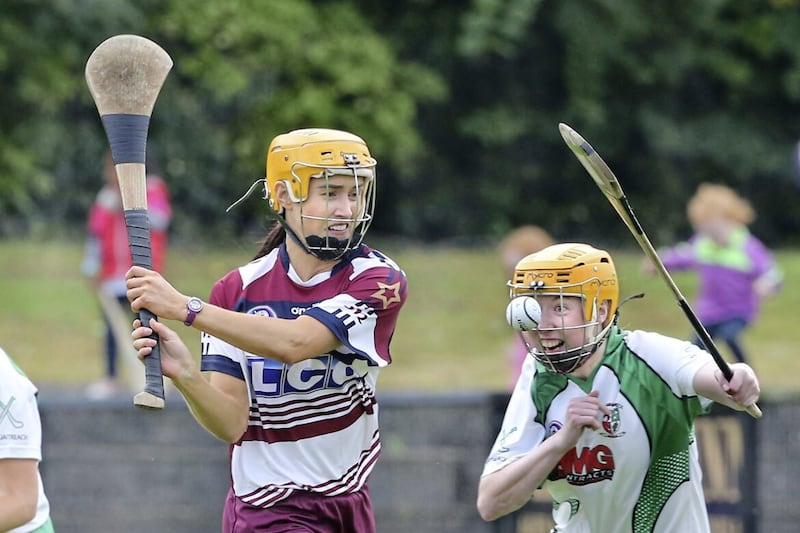WHEN the tractor and trailer turned up Hall Lane, past St Brigid’s Primary School, the Lavey players knew where they were headed. Twenty-five or so of them were squashed in like cattle, hands and feet hanging out of every orifice their auxiliary transport could offer.
It’s 1990. Aiming to win back the Derry title they’d claimed under John Brennan in 1988, their new manager Brendan Convery arrived to training one night in the slightly unusual mode of transport and told the lads to get on. Off they went. The journey took five minutes. A bit over a mile to Scullion’s Hill, out the back of Mayogall.
When they got there, the trailer was unloaded and they ran. Up and down it, they ran. Testing their legs. Testing their lungs. Testing their spirit. It has the character of many a Lavey team sculpted on the side of it, that hill. When they were done, they loaded back up again, and Brendan Convery drove them to the bar. A few well-earned refreshments, and then home.
Convery’s unique methods were partly what made that Lavey team so great. There was nothing particularly unusual about a team running up the side of a mountain in those days, but the former schoolteacher always held an eye for something different.
For example, a couple of nights he landed to training with Loup man and Irish rugby legend Willie Anderson. He took the concept of the offload and translated it to Gaelic football, helping implement a sharp hand-passing system that was ahead of its time.
“Because we knew we had a good enough side to win a Championship, he always brought a fun element to training,” says former Lavey and Derry great Seamus Downey.
“Paddy Chivers would have taken the training, but Brendan was the manager and he would have had a different view of things.”
When they lost their titles to Dungiven late in 1991, the senior players formed their own fundraising committee. They raised money throughout 1992 and, having won their second Ulster title after beating Burren in a replay, they went on a 10-day holiday to Tenerife to prepare for their All-Ireland semi-final with Skibbereen.
That was Lavey at that time. A step ahead. The players trained fiercely, as hard as any now. Colm McGurk was in his final year of architecture at Queen’s. A whippet of a corner-forward, often times he would hit the gym to run six kilometres at lunchtime before training that evening.
The knee strap that was so distinctive through Seamus Downey’s career with Derry was as a result of tearing his posterior cruciate ligament in 1989. He missed a year of football but, rather than have the operation, he rebuilt the knee by following a programme given to him by former Ireland rugby international David Irwin. Irwin had suffered the same injury and returned to the green jersey without an operation.
Downey followed it religiously, doing weight training on the leg between five and seven times a week: “It affects my dancing, but apart from that…”
The knee gives him no gyp, but two hip replacements before the age of 50 are the unwanted legacy of Downey’s GAA career. What they also had was an incredible level of consistency in terms of their team selection.
The team was bursting with lads in their mid-20s when the run started under John Brennan - another winner with his own methods - in 1988. It stayed a solid unit until after they beat Swatragh in the St Stephen’s Day snow three months after Derry had brought Sam Maguire home.
“We were fortunate in that we played 10 games and, in those 10 games, we only used 18 players. We were fortunate with injuries,” recalls Downey.
And they managed to do it all while hurling. Twelve times between 1985 and 2002, they won the Derry hurling title. So many of them featured for their county in both codes. They still regret not winning an Ulster Club hurling title. They had Dunloy, Ballycastle, Rossa and Cushendall all on the rack in different years, but could never quite get over that particular hill.
******
THE defining afternoon of Lavey’s 1990/91 campaign was not in Croke Park against Salthill.
It wasn’t against the vaunted Thomas Davis of Dublin, nor in the Ulster final, nor the Derry final: “The three finals we played, the Derry, Ulster and All-Ireland finals, actually ended up our easiest games,” recalls Downey.
It wasn’t even in beating a very strong Naomh Columba side from Donegal in their first outing in Ulster. It was, in fact, their All-Ireland quarter-final win over London champions Tír Chonaill Gaels. They were still in the midst of celebrating their Ulster final win over Kingscourt when The Irish News sprung the surprise on them. A few days after the Ulster final, the back page of the paper broke the news that the exiles were on their way to Ballinascreen.
Against a star-studded team that included James McCartan, Mattie McGleenan and Henneberry brothers Seamus and Robbie, Lavey found it tough to get back on the horse. Two minutes into injury-time, against the backdrop of a touchline punch-up seconds earlier, 42-year-old Anthony McGurk rescued it from the flames.
Damian Doherty was up from corner-back and his shot came off the post, rebounding into the path of the former Allstar McGurk, who punched home to send the game to extra-time. There, Lavey’s fitness bore out. Anthony McGurk again had the defining impact, landing a superb late free to edge the Derry champions through by 2-11 to 1-12.
“They had a super team and that was a hell of a game,” recalls Downey.
“The luck that deserted us in some of our other Derry campaigns after that, we had it all in our All-Ireland campaign.”
Two years later, after winning their second Ulster, fate had it that they’d to travel to Ruislip to meet Tír Chonaill again. It wasn’t the same Gaels side, but those who remained had allowed the wounds to fester.
London hurling champions St Gabriel’s had beaten Cushendall in an All-Ireland hurling quarter-final the week previous, and when Lavey arrived to the pitch, the scoreboard had been left up. A gentle reminder of what they would face.
They had been forewarned. A couple of Banagher men visited the team hotel the night before the game to inform them of the “depth of feeling” that remained from their previous battle. Johnny McGurk was split within seconds of the throw-in. The game was played under a dark air. Scores of supporters had made the trip but many more were at home, gathered in the clubhouse.
There weren’t many mobile phones about in the winter of 1992, but Harry Chivers’ came in useful that day. His voice boomed over a makeshift speaker system in the clubhouse. The first-half brought sporadic updates. The second-half was met by full match commentary. A village stood enthralled.
Lavey found themselves six points down early on but recovered to win deservedly, emerging to face Skibbereen, where their dreams of a second All-Ireland would fade: “That was a savage game [against Tír Chonaill]. They still had baggage about us beating them in Ballinascreen. But we went to their patch and beat them two years later. Those were two sweet victories,” recalls Downey.
******
THE 1991 semi-final pitted them against a Thomas Davis side that had beaten reigning All-Ireland champions Baltinglass after a replayed Leinster final.
The drawn game had been played in Newbridge in December, in front of a bus-load from Lavey who were making their second trip down the country. They had left the first day at 6am, joining a crowd of almost 10,000 in the Kildare ground. In the age before floodlights, throw-in was midday. But when they arrived an hour before the game, they knew there’d be no game. The fog was so dense that the game had to be postponed.
One of their own, Eugene Halferty, owned the Brazen Head in Dublin. The bus stopped there. A great day became a great night: “Spirit and craic you can’t buy,” smiles Downey.
They headed back down and actually saw them in action a couple of weeks later, gathering a valuable insight into the new Leinster champions. When the Dubliners came up to Celtic Park in February, it was a Hugh Martin McGurk penalty just over 10 minutes from time that got the better of them and booked Lavey’s place in the decider.
In Croke Park, it was Brian McCormick’s star than shone brightest. He had come straight into their first county title winning team in 1988 as a 16-year-old. The blossoming number 11 was a sublime free-taker. There was a real elegance about his style, chipping almost effortlessly from the ground. He finished with 1-6 of his side’s 2-9 against Salthill, but there was so much more to their attacking performance.
On YouTube, there is a video of Don Mulholland’s goal in the final. As a Salthill defender gathers the ball, there are six orange jerseys in the shot. They hound him until he makes the mistake, and Mulholland punishes.
They had to be different. It was a fiercely competitive era of Derry club football, at a time when the county was on its way towards their historic Sam Maguire success. In a six-year period at that defining time, Lavey won four Derry football titles, two Ulsters and one All-Ireland club. There were also 12 hurling titles between 1985 and 2002, with a huge overlap of players.
There were savage battles with Dungiven, who knocked the All-Ireland crown off their heads in the autumn of ’91. Battles in both codes, indeed. Newbridge, Ballinascreen and Swatragh were also particularly strong at the time. A new crop was on the way through in Bellaghy, which would reach the All-Ireland decider of 1995.
Like all success, it didn’t come from nowhere. The hard work of former Derry star Paddy Chivers with the club’s underage crop just prior to that time went a long way towards building the dynasty. Titles at U14 and U16 were followed by back-to-back minor championships in 1983 and ’84.
The club had success at senior level in what was then the premier league, winning a handful of league titles in the early-to-mid 1980s. They couldn’t get across the line in that time in the senior championship, but eventually that next wave came through and propelled them to the John McLaughlin Cup in 1988. That started a spell which culminated in them winning the All-Ireland.
Now, many of the faces of that era put their energies back into the club’s underage, just as Paddy Chivers did. The project is 13 years ongoing, and is just beginning to bear fruit from U16 down. For the next few weeks, they will look forward to March 11. The Tullyglass Hotel will host an event to mark both 25 years from their All-Ireland success, and 90 years since the Erin’s Own club was formed.
“We had jackets and ties from ’91, and I got my jacket out the other day and it still fits. I might even have to get it taken in,” Downey smiles.
******
THEY were both on the hallowed turf in 1993, of course. Seamus Downey one of the goalscorers at full-forward, Colm McGurk on the bench as Derry beat Cork to win Sam Maguire for the first and only time. The final whistle that afternoon sounded familiar, yet different.
On Derry’s September Sunday, half the crowd was already sat around the side of the pitch. The whistle hadn’t gone five seconds and the entire pitch was a sea of red and white. Trying to get to the Hogan Stand for the presentation was only the beginning of a chaos that engulfed the county for months.
If Lavey’s representatives didn’t ease off the celebrations, they disguised it well. It still gives them immense satisfaction to have won the county title that year: “We wanted to win the Derry club championship the year that Derry won the All-Ireland. We had a week after Derry finished until we were back at it, because the club championship had been held up,” said Seamus Downey.
Eighteen months (almost to the day) previous, the whole townlands of Lavey, Gulladuff, Mayogall combined to help fill a few thousand seats at the Jones’ Road venue. A 2-9 to 0-10 win over Galway and Connacht champions Salthill - themselves unfamiliar to the stage they found themselves on - brought the Andy Merrigan Cup back to the Oak Leaf county for the first time since 1972, when their neighbours Bellaghy had won it.
“Probably the club success resonates better with you because of who you grew up with and played with,” said Downey.
“It’s a different magnitude to the Derry victory. I wouldn’t say the celebrations lasted any longer, they were just on a different level. The two successes sit differently. I wouldn’t say one’s better or any more important than the other, but it’s just a different type of experience.”
McGurk adds: “That’s probably the best feeling you’ll ever have as a club player. You’ll never get that high again. Coming through the doors of the club that night.”
When referee Tommy Howard came across to ask for the ball on St Patrick’s Day 1991, Lavey full-back Anthony Scullion thought he had been blown for over-carrying. On the video, you can see him taken aback by the decision, before turning to head back for his own goal.
Scullion was one of the unsung men of that team. A rock on the edge of his own square, he was a superb footballer, and Damian Doherty and Brian Scullion weren’t to be messed with either. In front of him, Henry Downey was the team’s leader; Johnny McGurk its captain and another huge inspiration. Ciaran McGurk flanked him on the other side, with two more brothers, Hugh Martin and Colm, in attack.
“From when we came out of minor, there were players like Séan McCrystal and Eugene Laverty in particular who were there and helped bring the team through difficult times when we were trying to grow as a young side,” says Colm McGurk.
“They allowed Henry to grow to become the team’s leader. Whenever Brendan [Convery] came in, the team’s leaders were established.”
Brendan Regan, whose spectacular save from Pat Comer early in the second half proved pivotal in the final, was another major presence. He had two towering men in James Chivers and Damien O’Boyle to kick at.
Fergal Rafferty and Hugh Martin McGurk were ahead of their time, filtering back naturally when Lavey lost the ball. They were two of the more experienced faces, but their work-rate never wavered. A full-forward line of Don ‘Shaq’ Mulholland, Seamus Downey and Colm McGurk was one that offered a mix of everything.
If you needed a window into what really made that Lavey team special, though, it’s in Colm McGurk’s competitiveness. At the very outset of a chat that runs for over an hour, he recalls the afternoon on which he, Downey and his brother, 1993 captain Henry, all retired.
A relegation play-off in 2006 against Foreglen, McGurk was almost 40, the other two 38 and 39 respectively. He togged out but Seamus Downey, as player-manager, didn’t start him: “I’m still crabit about it.”
In their magnificent new £2.5m indoor facility, built in conjunction with Termoneeny Community Association and which houses underage training 12 months of the year, there is a veterans’ day every Thursday.
At the end of the chat, Downey ribs McGurk that he’ll soon qualify: “I’ll be the treadmill champion though,” is the answer.
Desperation to succeed, right to the last. With men of that mentality, Lavey are in safe hands.







